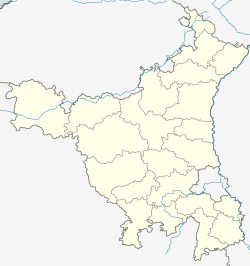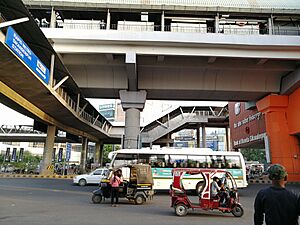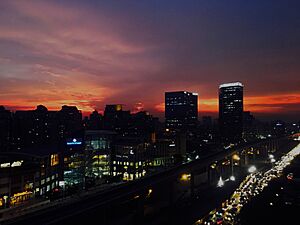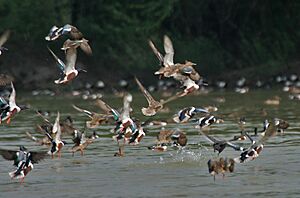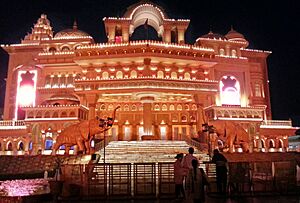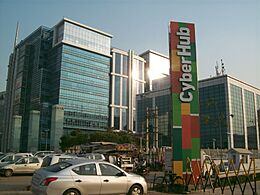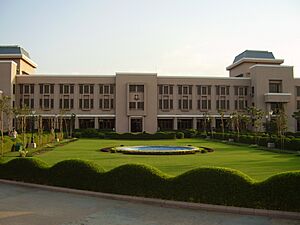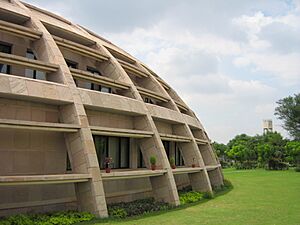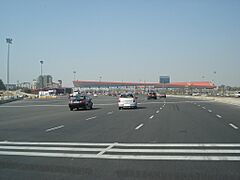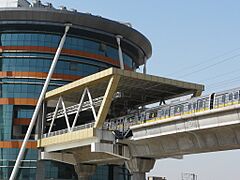Gurgaon facts for kids
Quick facts for kids
Gurgaon
|
|
|---|---|
| Gurugram | |
|
Gurgaon city skyline along with the Rapid Metro
Kingdom of Dreams
Gateway Towers
DLF CyberCity
Sultanpur National Park
|
|
| Nickname(s):
Millennium city
|
|
| Country | India |
| State | Haryana |
| District | Gurgaon district |
| Created | 1979 |
| Government | |
| • Body | Gurgaon Municipal Corporation |
| Area | |
| • Total | 332.50 km2 (128.38 sq mi) |
| Elevation | 217 m (711.9 ft) |
| Population
(2011)
|
|
| • Total | 876,969 |
| • Density | 2,637.50/km2 (6,831.10/sq mi) |
| Languages | |
| • Official | Hindi |
| Time zone | UTC+5:30 (IST) |
| PIN |
122xxx
|
| Area code(s) | 0124 |
| Vehicle registration | HR-26 HR-98 HR-55 (commercial) |
| HDI (2017) | |
Gurgaon (Hindi: [ɡʊɽɡãːw]), officially called Gurugram ([ɡʊɾʊɡɾaːm]), is a big city in Haryana, India. It is very close to New Delhi, India's capital. Gurgaon is about 30 kilometres (19 mi) southwest of New Delhi. It is part of the National Capital Region. In 2011, about 876,969 people lived here.
Gurgaon is a major center for information technology and banking in India. It is also known for medical tourism, where people travel for medical care. Even though it's not the biggest city by population, Gurgaon is one of the wealthiest cities in India. Many large companies have their main offices here. Over 250 of the world's biggest companies (from the Fortune 500 list) have offices in Gurgaon. This city gets a lot of the money invested in Haryana state. This has made it a top place for high-tech industries in northern India.
Gurgaon's economy started growing in the 1970s. This happened when Maruti Suzuki India Limited opened a car factory. Later, General Electric started its business operations here. This was done with the help of DLF, a real estate company. Places like Manesar and Sohna are also growing as manufacturing and housing areas near Gurgaon. Despite its fast growth, Gurgaon still faces challenges. These include differences in income and air pollution. It also has problems with flooding because its drainage system is not big enough.
Contents
History of Gurgaon
The area where Gurgaon is now was once part of the Kuru Kingdom. Early people living here were Hindus. They were ruled by the Ahir clan. The Yadu tribes were part of this clan. Today, many of their descendants have the last name Yadav. Around 400 BCE, the city became part of the Maurya Empire. This happened during Chandragupta Maurya's early expansion.
Some people think Gurgaon might be the same as Gudapura. This town is mentioned in a text from the 12th century called Prithviraja Vijaya. The text says that Nagarjuna, a cousin of King Prithviraj Chauhan, took over the town. But Prithviraj quickly defeated him and took the town back.
During the Mughal and early British times, Gurgaon was a small village. An old report from 1885 mentions a stone pillar in Gurgaon. It belonged to a local lord named "Durgga Naga" and dates back to 672 CE or 871 CE. In 1818, Gurgaon became a new district.
Many old buildings were built during the Mughal and British times. These include the "Aliwardi mosque" and the "Badshahpur baoli" (a stepwell). The British also built the "Church of the Epiphany" in 1925. The Gurgaon Club is another old building, now run by the local council. The former Coronation School, now called Government Boys' Senior Secondary School, was built in 1911. It was one of 13 schools built in India to celebrate the crowning of King George V.
On April 12, 2016, the Chief Minister of Haryana suggested renaming the city Gurugram. This name means village of the Guru in Sanskrit. He said it would help keep the city's "rich heritage." The name change was approved on September 27, 2016. So, the city and district are now officially known as Gurugram. However, many people still use the old name "Gurgaon."
Geography and Nature
Gurgaon is in the state of Haryana, India. It is in the southeastern part of the state. The city is right on the border with Delhi. New Delhi is to its northeast. Gurgaon covers a total area of about 232 square kilometres (90 sq mi). The land is about 217 metres (712 ft) above sea level.
Natural Areas and Wildlife
Gurgaon is located near the Sahibi River. This river flows from the Aravalli range in Rajasthan. It goes through Haryana and into Delhi. Along the Sahibi river, there are many important natural areas. These include wetlands and forests. Some famous spots are Sultanpur National Park and Basai wetland. These places are homes for many different animals and migratory birds. Many of these areas need protection. They are at risk from new buildings and development.
Mangar Bani is a special forest area between Gurgaon and Faridabad. It is one of the last natural forests in the National Capital Region. Local people protect it. This forest is part of the Southern Delhi Ridge of the Aravalli hills.
Weather in Gurgaon
Gurgaon has a climate that mixes a humid subtropical climate with a hot semi-arid climate. This means it has four main seasons. These are spring (February–March), summer (April–August), autumn (October–November), and winter (December–January). There is also a monsoon season from June to September.
Summers are usually hot and humid. The average high temperature in June is 40 °C (104 °F). Winters are cool and often foggy. Sometimes, rain in winter makes it even colder. Spring and autumn are mild and pleasant. The monsoon season brings rain, usually starting in July. The average yearly rainfall is 648.6 millimetres (25.5 in). The hottest temperature ever recorded was 49.0 °C (120.2 °F) in May 1966. The coldest was −0.4 °C (31.3 °F) in December 1966.
| Climate data for Gurgaon (1991–2020, extremes 1965–2000) | |||||||||||||
|---|---|---|---|---|---|---|---|---|---|---|---|---|---|
| Month | Jan | Feb | Mar | Apr | May | Jun | Jul | Aug | Sep | Oct | Nov | Dec | Year |
| Record high °C (°F) | 28.0 (82.4) |
33.5 (92.3) |
39.5 (103.1) |
44.8 (112.6) |
49.0 (120.2) |
47.5 (117.5) |
45.0 (113.0) |
41.0 (105.8) |
41.2 (106.2) |
39.3 (102.7) |
38.4 (101.1) |
30.2 (86.4) |
49.0 (120.2) |
| Mean maximum °C (°F) | 25.0 (77.0) |
29.2 (84.6) |
35.7 (96.3) |
42.9 (109.2) |
45.0 (113.0) |
45.0 (113.0) |
40.6 (105.1) |
38.1 (100.6) |
37.2 (99.0) |
35.2 (95.4) |
32.8 (91.0) |
26.6 (79.9) |
45.7 (114.3) |
| Mean daily maximum °C (°F) | 20.1 (68.2) |
23.8 (74.8) |
29.9 (85.8) |
36.9 (98.4) |
40.9 (105.6) |
39.3 (102.7) |
35.9 (96.6) |
33.9 (93.0) |
34.1 (93.4) |
32.0 (89.6) |
27.8 (82.0) |
22.5 (72.5) |
31.2 (88.2) |
| Mean daily minimum °C (°F) | 6.9 (44.4) |
9.5 (49.1) |
14.0 (57.2) |
19.6 (67.3) |
24.6 (76.3) |
26.7 (80.1) |
26.7 (80.1) |
25.8 (78.4) |
24.4 (75.9) |
18.0 (64.4) |
12.0 (53.6) |
7.5 (45.5) |
17.7 (63.9) |
| Mean minimum °C (°F) | 3.9 (39.0) |
4.9 (40.8) |
8.6 (47.5) |
14.5 (58.1) |
19.1 (66.4) |
21.6 (70.9) |
23.5 (74.3) |
23.1 (73.6) |
21.8 (71.2) |
13.2 (55.8) |
7.3 (45.1) |
3.5 (38.3) |
3.0 (37.4) |
| Record low °C (°F) | 0.0 (32.0) |
0.9 (33.6) |
3.7 (38.7) |
9.2 (48.6) |
14.8 (58.6) |
19.1 (66.4) |
21.0 (69.8) |
21.2 (70.2) |
13.9 (57.0) |
9.8 (49.6) |
2.6 (36.7) |
−0.4 (31.3) |
−0.4 (31.3) |
| Average rainfall mm (inches) | 13.5 (0.53) |
16.9 (0.67) |
3.4 (0.13) |
8.2 (0.32) |
22.7 (0.89) |
79.2 (3.12) |
135.5 (5.33) |
211.4 (8.32) |
120.8 (4.76) |
15.9 (0.63) |
10.7 (0.42) |
9.9 (0.39) |
648.6 (25.54) |
| Average rainy days | 1.2 | 1.2 | 0.5 | 0.6 | 1.7 | 4.3 | 7.6 | 8.5 | 5.5 | 1.3 | 1.0 | 0.8 | 34.2 |
| Average relative humidity (%) (at 17:30 IST) | 54 | 45 | 37 | 28 | 31 | 40 | 63 | 69 | 59 | 45 | 47 | 55 | 48 |
| Average dew point °C (°F) | 8 (46) |
9 (48) |
11 (52) |
11 (52) |
14 (57) |
20 (68) |
24 (75) |
25 (77) |
23 (73) |
16 (61) |
11 (52) |
8 (46) |
15 (59) |
| Average ultraviolet index | 5 | 5 | 7 | 9 | 9 | 9 | 8 | 7 | 7 | 7 | 6 | 4 | 6.9 |
| Source 1: India Meteorological Department
Time and Date (dewpoints, 1985-2015) |
|||||||||||||
| Source 2: Weather Atlas | |||||||||||||
People and Culture
Population and Religions
In 2011, about 876,969 people lived in the city area of Gurgaon.
| Religion in Gurgaon City (2011) | ||||
|---|---|---|---|---|
| Religion | Percent | |||
| Hinduism | 93.03% | |||
| Islam | 4.68% | |||
| Sikhism | 1.00% | |||
| Christianity | 0.64% | |||
| Others | 0.39% | |||
Most people in Gurgaon follow Hinduism. Other religions like Islam and Sikhism are also practiced. There are smaller numbers of Christians and Buddhists. Gurgaon has many places of worship. You can find mandirs, gurdwaras, mosques, and churches here.
The Sheetla Mata Mandir is in the center of Gurgaon. It is a temple dedicated to Kripi, the wife of Guru Dronacharya. People visit this temple to ask for blessings.
City Design and Buildings
Gurgaon has many modern buildings. Its skyline, with lots of skyscrapers, is well-known in India. The city has many tall buildings with modern designs. There are about 1,892 high-rise buildings in Gurgaon.
Neighborhoods and Parks
Gurgaon is divided into 36 areas called wards. Each ward has smaller blocks. Most homes are attached houses. However, many apartments and high-rise residential towers are becoming popular.
The city has many parks managed by the Gurgaon Metropolitan Development Authority. Some main parks include Leisure Valley Park and Tau Devi Lal Biodiversity Botanical Garden. There are also local parks in almost all parts of Old Gurgaon.
Entertainment and Arts
For entertainment, you can visit Epicentre or Nautanki Mehal. Nautanki Mehal is located at the Kingdom of Dreams. This is a popular place for shows and performances.
Languages Spoken
The main language in Gurgaon is Hindi. Many people also understand and speak English. The Hindi spoken here is similar to that in Delhi. However, you might hear accents from Haryana, Uttar Pradesh, and Punjab. English is spoken with an Indian accent. Many international call centres are in Gurgaon. Their employees often get training to speak English clearly for people from other countries. Haryanvi and Punjabi are also popular languages in the city.
Sports and Recreation
Gurgaon has two main sports stadiums. The Tau Devi Lal Stadium has facilities for cricket, football, basketball, and athletics. It also has a sports hostel. The Nehru Stadium is for football and athletics. Gurgaon district has nine golf courses. It is known as a great place for golfing in India.
Economy of Gurgaon
Gurgaon has one of the highest incomes per person in India. It is home to Indian offices for half of the Fortune 500 companies. The city also benefits from being close to Delhi.
Maruti Suzuki Private Limited was the first big company to open a factory here in the 1970s. They made cars. Later, DLF Limited, a real estate company, bought a lot of land in the city. The first major American company to set up in Gurgaon was General Electric in 1997. This encouraged other companies, both from India and other countries, to come to Gurgaon. They offer services like software, IT, and call centers.
Besides IT and business services, Gurgaon has many other companies. For example, Siemens Industry Software makes design software. This software was used by NASA to design vehicles digitally. Many international companies like Coca-Cola, Pepsi, BMW, and Hyundai have their main Indian offices in Gurgaon. Companies like Air India, IndiGo, SpiceJet, and Vistara also have their main offices here.
Gurgaon is also a big center for shopping. It has 26 shopping malls.
Education in Gurgaon
The public schools in Gurgaon are managed by the government of Haryana. There are also many private schools. These schools follow different education boards. Some well-known schools include Alpine Convent School, Amity International School, and Delhi Public School.
Gurgaon and its surrounding areas have several universities and institutes. They offer many different study programs. Some of these include Gurugram University, Sushant University, and The NorthCap University.
Getting Around Gurgaon
Roads and Highways
The main highway connecting Gurgaon is National Highway 48. This road goes from Delhi to Mumbai. The part of the road from the Delhi-Gurgaon border to Kherki Dhaula is a special expressway.
Trains and Metro
Intercity Trains
The Gurgaon railway station is part of the larger Indian Railways network. Other railway stations in Gurgaon include Tajnagar and Dhankot. Indian Railways is working to make these stations more modern.
Delhi Metro
The Yellow Line of the Delhi Metro Rail Corporation Ltd. serves Gurgaon. There are five metro stations in the city. These include Millennium City Centre and Sikanderpur. There are plans to add more metro lines in the future.
Rapid Metro
The Rapid Metro has eleven stations in Gurgaon. You can switch to the Delhi Metro's Yellow Line at Sikanderpur metro station. The Rapid Metro started running in November 2013. It covers a distance of about 11.7 kilometres (7.3 mi). About 33,000 people use the Rapid Metro every day.
Air Travel
Airport
Gurgaon is served by Delhi's Indira Gandhi International Airport. This airport is just outside Gurgaon.
Public Transport Initiatives
In November 2013, Gurgaon started "Raahgiri Day." On Sunday mornings, some streets are closed to cars. This encourages people to walk, bike, and do outdoor activities. Gurgaon was the first city in India to do this.
City Services
Electricity in Gurgaon comes from a government company called Dakshin Haryana Bijli Vitran Nigam. Gurgaon has about 360,000 electricity users. However, there are often power cuts, especially in summer. This is because the power equipment is old or too busy.
Challenges in Gurgaon
Flooding Problems
Gurgaon often experiences floods during the monsoon season. Areas like Hero Honda Chowk and Basai get very flooded. This causes huge traffic jams. Research shows that this happens because natural water paths have been blocked. Also, the city's drainage system is not big enough.
Gurgaon's natural lakes and ponds, like Ghata Jheel, used to connect to the Najafgarh drain. This drain then leads to the Yamuna river. But these natural water bodies are now struggling. Buildings have been built on their land and natural channels. Authorities have tried to create new water bodies. However, these efforts often fail because of unpredictable rain.
See also
 In Spanish: Gurgaon para niños
In Spanish: Gurgaon para niños







